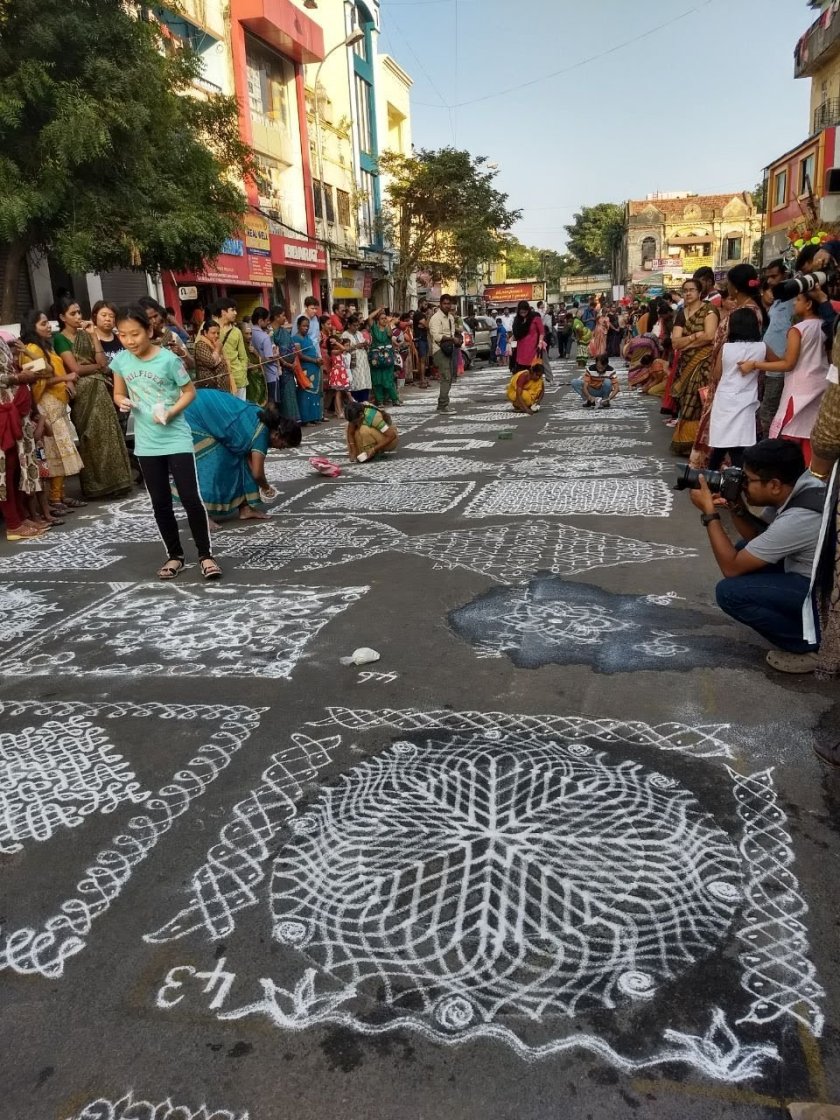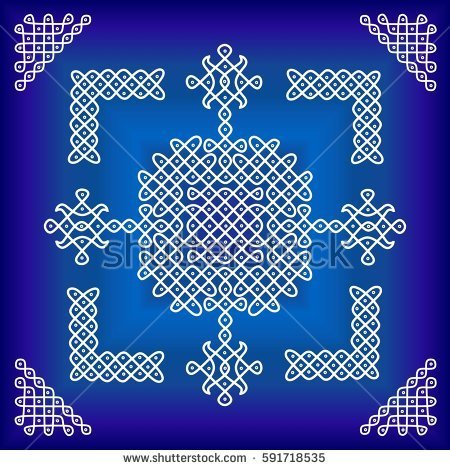In many South Indian homes, the day begins when the lady of the house goes to her courtyard or front porch, washes it with water, and draws a kolam, which is artwork that usually uses dots. These dots are connected together, in many ways, to create visual treats.
Kolams are usually drawn free hand, with rice flour. The rice flour is gripped between the thumb and the pointer finger. As the hand makes the required movement, the rice flour is dropped at an even pace! And lo! In less than three minutes a beautiful kolam is ready.
When we were children, we took turns to draw the kolam every morning. As the first rays of the sun fell on our little town, one of us would take a pail of water, and wash the area around the threshold of the house. With a broom made of sticks, we would sweep the yard and remove all excess water. Then, we would get the bowl with the rice flour and start drawing the kolam.
We were usually taught these basic designs by our grandmoms or aunts or moms. As with any new art form, the kolams we created were distended and uneven, with fat lines. With practice, we got better.
We were given free rein to draw any kolam we wanted.
Starting off with 2 x 2 dot matrices, we moved on to 3 x 3, 4 x 4….and then 10 x 10, and to other shapes like triangles and circles!
Some of the designs are so intricate that they require a lot of concentration- one wrong move, and the whole kolam needed to be reworked!
![]()
Courtesy – http://www.shutterstock.com
The satisfaction from learning and completing a kolam was immense.
The kolam is usually drawn as a sign of welcome to visitors, and also to bring prosperity to the home.
Kolams are also believed to have provided food to little birds and ants, so that they did not have to go too far away in search of food.
There are special kolam designs for festivals that we celebrate. These kolams are usually made with liquid rice flour. I put special kolams at home for every festival!
In the city of Chennai in India, there is a kolam competition every year, in the month of marghazhi in the Tamil calendar, which falls between 15 Dec and 15 January. People participate enthusiastically; and the whole street reverberates with creativity and excitement!
Sharing two pictures of this year’s competition that were shared by my cousin and my friend.


Wedding Kolams are elaborate, and usually every home has an aunt or grandma, who excels at wedding kolams. Such kolams can be nearly 3 feet in diametre. It is back breaking work for the woman who usually draws the kolam.

Courtesy – http://www.shutterstock.com
When my mind wanders far away, and my hands start doodling, it is mostly kolam patterns that I end up drawing. Last night, I did precisely that!

My kolam doodles from last night…the inspiration for this post!
Kolams are much like our lives. There are dots and lines. Dots are like the important milestones or stages in our lives. The lines represent our journey. Sometimes life is smooth, sometimes life gets knotted and complicated, sometimes all the dots connect beautifully, and then life is perfect!

Lovely patterns formed by the dots and lines.
LikeLiked by 1 person
Thank you!
LikeLike
Beautiful ! The sad part is when it has to be washed away. It’s an art in itself☺
LikeLiked by 1 person
True Savitha. But each time it gets washed away there are new opportunities to create again!
LikeLiked by 1 person
Lovely Nimi. My granny is from Orissa, there also they make Alpana (Kolam) every morning. We make it every Diwali and it is called Rangoli. But here you have given a wealth of information on it. Thank you!
LikeLiked by 1 person
Oh wow, Shivangi. Thank you for sharing! We visited Odisha the year before last. We had an awesome trip.
LikeLiked by 1 person
I am sure you must have had.
LikeLiked by 1 person
😃😃
LikeLiked by 1 person
I learn the most interesting things over here, Nimi. These are beautiful. It’s a joy to read your posts.
LikeLiked by 1 person
Those are amazing. I love how everything is made do sacred and conscious.
LikeLike
These are all great!
LikeLiked by 1 person
Thank you, Marissa
LikeLike
I like the green pattern that looks like candles in a fancy candlestick. Very intricate and scientific plus creative.
LikeLiked by 1 person
Yes…it’s a lot of work. Kolams are also being used as a form of therapy these days!
LikeLike
Wow that’s awesome!
LikeLiked by 1 person
Fascinating!
LikeLiked by 1 person
Thank you, Ken!
LikeLiked by 1 person
They are so beautiful. Wonderful thoughts.
LikeLiked by 1 person
Thank you so much
LikeLike